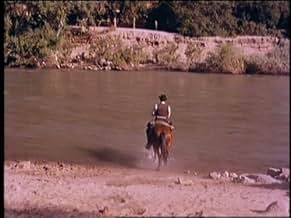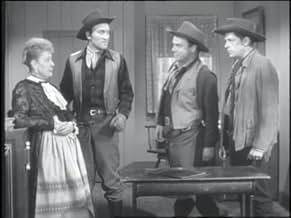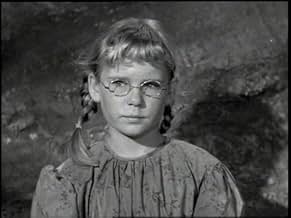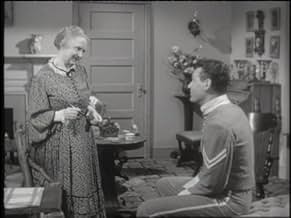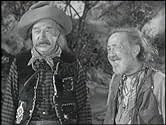Ajouter une intrigue dans votre langueThe adventures of the masked Texas Ranger and his Native American partner.The adventures of the masked Texas Ranger and his Native American partner.The adventures of the masked Texas Ranger and his Native American partner.
- Nommé pour 2 Primetime Emmys
- 3 nominations au total
Avis à la une
As an adult and watching the earliest episodes, it occurred to me that Tonto, actually gave all the idea's for his partners image. It was Tonto that suggested the mask. It was Tonto that suggested the silver bullets, and it was Tonto that came up with the name for Silver..when he proclaimed that the horse the Lone Ranger saved from death was "Silver White"! At last, as Tonto stood with the lone surviving Ranger over the graves of the others, Tonto, proclaimed "You are all alone now..You Lone Ranger! Of course, the response was "Yes Tonto, I am..The Lone Ranger!
The bonds of friendship and trust for the Lone Ranger and Tonto, was used 25 years later as an example of true friendship in an episode of Happy Days. In this particular episode, where Ritchie wanted to expose Fonzie for hating liver. The remark from Fonzie that typified what a true friendship should be was this "Many people tried to remove the mask of the Lone Ranger, but Tonto "never tried". All of America knew and felt that the truest of friendships would be to be like The Lone Ranger and Tonto.
Clayton Moore and Jay Silverheels are beloved for more than just being actors in a great western that will live forever. They are symbolic of so much more and as I said..will always be my hero's.
Also note that some of the first episodes are very short - in some cases only 11 or 12 minutes long. That is because sometimes the sponsor would put two short serials in the same half hour slot. The time really belonged to the sponsor back in those days, and thus early TV schedules looked a lot like radio at first.
One of my favorite episodes was "The Silent Voice" towards the end of season two. The witness to a crime is a stroke victim who is completely paralyzed. The Lone Ranger comes up with a way for the woman to communicate by blinking in response to letters of the alphabet.
The other episode from this early part of the series that sticks out is one in which the wife in a husband/wife crime team betrays the husband and shoots him. He is presumed dead and taken to the undertaker's. The Lone Ranger discovers that the husband is not dead, and the husband makes a confession as to what is going on before he dies as he lies on a slab about to buried - alive. The Lone Ranger tricks the wife by claiming that her husband is still alive. That's what I liked about the Lone Ranger - it really could be very dark. There would always be the happy ending with the criminals rounded up and jailed, but that didn't mean that some good people didn't fall along the way or that something really creepy or cringe-worthy wasn't part of the plot.
Highly recommended if you ever get the chance.
The new DVD set from Pop Flix contains the first 16 episodes (15 Sept-29 Dec 1949) and for some reason unknown to me episode 22 from the fifth season, for a total of 17 episodes (the same 17 available on last year's Mill Creek Entertainment release so these are probably in the public domain). These sets pretty much render "The Legend of the Lone Ranger" movie superfluous as all three episodes that were combined in 1952 to form the movie are included in these releases.
The early episodes hark back to radio as there is considerably more voice-over narration used as an introduction and to introduce key plot moments.
The series itself was pure kiddie western with clear-cut good and evil distinctions and no romance. The title character (played by Clayton Moore) started out Texas Ranger John Reid. The first three episodes provide the background for his transformation to Lone Ranger status, his partnering with the Indian Tonto (Jay Silverheels), and the taming of his horse "Silver".
There is an unambiguous code of positive morality infusing each episode. The Lone Ranger is totally good but he adopts the guise of evil. While a masked man in the west was normally feared by the good citizens and an Indian was distrusted, the Lone Ranger is feared by those who would do evil. One persistent theme is that when the Lone Ranger and Tonto first encounter an average citizen they are greeted with suspicion, and by the end of the episode the citizen has been convinced of their value. The trademark ending was a secondary character asking the question: "who was that masked man?".
To really enjoy the series you must accept it for the simplistic morality tale it was intended to be. If you don't take it seriously and keep wishing for some self-reflexive campy parody elements you will only get frustrated.
Then again, what do I know? I'm only a child.
I suspect that most people reading this will have at least some knowledge of this series, but I'll give a brief synopsis of it anyway. A group of six Texas Rangers go riding after an outlaw gang (the Cavendish Gang). The Rangers are being led into a trap by a scout who is working for the gang and five of them are killed in an ambush. The sixth, a man named Reid, survives, in no small part due to the help of an Indian named Tonto who, in a twist of an improbable nature, met him once before, when Tonto was a boy. Reid helped him then and he returns the favor, calling Reid "Kemo Sabe".
Reid recovers and decides to take up a secret identity to track down and bring to justice bad guys. He dons a black mask and a white hat, calling himself "The Lone Ranger". He saves and then tames a wild white stallion he calls Silver. Having a secret silver mine, he covers his expenses and manufactures silver bullets from the ore taken from the mine. Thus is a hero born.
Clayton Moore played the title character most of the series, though John Hart assumed the role for 52 episodes after the first 78 were produced. When Hart wasn't accepted as the character by audiences, Moore returned. Jay Silverheels played Tonto for the entire run, appearing in virtually every episode. Lots of recognizable faces appeared in the series, most of them before they became famous, like DeForrest Kelly, pre-Star Trek and Victor Sen Yung, pre-Bonanza.
This series is available on DVD, most notably the Classic Media The Lone Ranger: Collector's Edition, a 30 disc release containing all 221 episodes. The set is excellent and well worth having if you're a fan. Recommended.
Le saviez-vous
- AnecdotesThe Lone Ranger's young nephew, Dan Reid, who appeared occasionally on this show, was the father of Britt Reid, The Green Hornet. Both characters were created for radio by George W. Trendle.
- GaffesIn the series opening used in syndication, the Lone Ranger is seen riding past rows of trees planted as wind breaks. This practice did not come into use until after the "dust bowl" windstorms of the 1930s.
- Citations
[first lines for each episode]
Narrator: The Lone Ranger!
[gunshots are fired]
The Lone Ranger: Hi-yo, Silver!
Narrator: A fiery horse with the speed of light, a cloud of dust and a hearty "Hi-yo Silver" - the Lone Ranger!
The Lone Ranger: Hi-yo, Silver, away!
Narrator: With his faithful Indian companion, Tonto, the daring and resourceful masked rider of the plains led the fight for law and order in the early West. Return with us now to those thrilling days of yesteryear. The Lone Ranger rides again!
- Versions alternativesThe first three episodes are available edited together as a ersatz feature "Enter the Lone Ranger" (1949) running 68 minutes minus titles and recaps.
- ConnexionsEdited into The Legend of the Lone Ranger (1952)
- Bandes originalesWilliam Tell Overture: Finale
(uncredited)
Written by Gioachino Rossini
[Played at program opening and during closing credits]
Meilleurs choix
- How many seasons does The Lone Ranger have?Alimenté par Alexa
Détails
- Date de sortie
- Pays d’origine
- Langue
- Aussi connu sous le nom de
- El llanero solitario
- Lieux de tournage
- Sociétés de production
- Voir plus de crédits d'entreprise sur IMDbPro
- Durée30 minutes
- Rapport de forme
- 1.33 : 1
Contribuer à cette page




